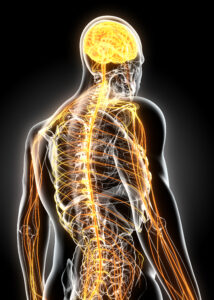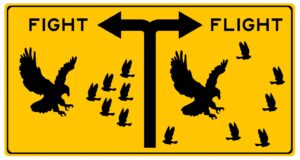Written in conjunction with Dr. Les Aria, PhD
Objectives
- Every function and action of your body is in a delicate balance. This is achieved by every action being combined with an almost equal opposite reaction.
- The autonomic nervous system regulates your internal organs, and the two parts are the activating sympathetic nervous system (SNS) and the calming parasympathetic nervous system (PNS).
- Sustained activation of the ANS causes illness and disease.
- There are ways of recruiting the PNS to counteract this process and heal.
The areas of the nervous system are named by location but are just different areas of one system. It consists of:
- Central nervous system
- Autonomic nervous system
- Spinal cord
- Peripheral nerves
- Sensory receptors

The autonomic nervous system
Every aspect of it is equally as critical for survival. The autonomic nervous system (ANS) regulates all the internal organs and chemical balance of your body. It is named as such because all of its functions are automatic. A few of its actions include regulation of:
- Heart rate
- Bowel and bladder function
- Regulation of acid/ base balance
- Respiration
- Sweating
- Blood pressure
- Immune response
- Level of alertness
- Rate of metabolism (energy consumption)
- Electrolyte balance
There are two parts to the ANS that are constantly active and counterbalancing each other – the sympathetic (SNS) and parasympathetic (PNS) systems. The SNS is often referred to as the physiological gas pedal. Its role is to activate your body’s defenses to fight off threats of any kind. The threats can be physical, mental, or emotional. For this discussion, we’ll categorize societal threats under physical threats. The threats may be real or perceived, but your SNS will respond in a similar manner.
Activated
This activated physiological state is called, “Flight or fight”. When your body is exposed to prolonged elevations of inflammation, metabolism, and stress hormones, different physical and mental symptoms will be manifested. When it is sustained, people develop serious illnesses and diseases, including chronic pain. The late phases of SNS activation are called, “freeze or faint” where there is systemic collapse of bodily functions. It is the body’s final survival attempt.
Calm
The most effective way of combatting and preventing chronic disease is to stimulate the PNS, which has the opposite effects of being anti-inflammatory, lowering metabolism, stimulating regenerative hormones, and calming the nervous system. The PNS is the physiological brake pedal. Remember that both the SNS and PNS are both almost equally active most of the time to maintain an incredibly delicate balance (homeostasis).
Your body has to be in a regenerative state of safety in order to heal and replenish itself. It is the common denominator of the various effective healing approaches and there are many ways to achieve this state. The foundation of the calming PNS effects is the vagus nerve. It is the 10th cranial nerve that originates in the midbrain, below your main body of the brain. It is connected to every internal organ in your body, including the immune system. Recruiting and reinforcing the vagus nerve is the most powerful way of inducing a relaxation response to counteract threat physiology.
Inducing relaxation – breath work
Research suggests we can induce this relaxation response of the PNS through various breathing exercises. Some of them include:
- Voluntary relaxed slow breathing exercises (e.g., diaphragmatic breathing and alternate nostril breathing and applications of mindfulness practices.1
- Engaging in slow breathing exercises during stressful experiences (mental or physical) at a rate of 6-10 breaths per minutes helps optimize ventilation gases, arterial oxygenation, gas exchange. Higher arterial oxygenation stimulates the PNS.
- Given the evidence and benefits of slow breathing exercises on health and well-being, and decreased mortality in diseased states, it is surprising that the medical community has not prescribed this effective and simple tool as part of a standard care of medical treatment for those struggling with acute and chronic diseases. Slow breathing exercises are a vital part of optimizing health.
- Slow long exhalations especially linked with deep short inhalations
- Alternate nostril breathing
- Breathing slowly through your nose – also stimulates Nitric Oxide release, which is powerfully anti-inflammatory.
- Meditation with deep breathing. Try using a counting method (such as 4 counts breathing in and 4 counts out; or 4 counts in, hold for 7, and release for 8); alternating nostril breathing (block one nostril while breathing in and the other nostril while breathing out); or just focus solely on your 2
Other PNS recruitment strategies
- Quiet humming – stimulates the 7th cranial nerve at the back of the throat, which is close to the vagus nerve
- Certain relaxing pitches of quiet music like a lullaby stimulate the 8th cranial nerve, which is also near the vagus nerve.3
- Other calming activities will stimulate the PNS
- Mindfulness/ meditation
- Biofeedback/ medical hypnosis
- Visualization
- Slow-movement martial arts
Understanding that using these tools directly effects your flight or fight response, helps you to engage and use them daily. Again, this is working with your physiology and the effect on your psychological state is secondary. Your physiology is what determines your mental state. It is desirable to stimulate the PNS as much as possible.

Recap
One of the basic premises of successfully solving chronic pain is taking control of your own care. One step deeper is directly stimulating the calming effects of the parasympathetic nervous system (PNS). There are multiple ways of making this happen, with breath work being one of the most accessible and it works quickly. However, you are addressing just one aspect of the body’s response to stress, which is the physiology (output). It is temporary and just part of the solution.
Addressing the input and the state of your nervous system are bigger picture strategies, but it is critical to have easy and direct access to your PNS.
Questions and considerations
- Have you wondered why techniques such as breathing, mindfulness, meditation and soft music are effective in calming you down? It is because they directly stimulate the ANS.
- These tools are only part of the solution, but a critical aspect of it. It is helpful to be able to quickly calm your body’s threat response. You can bypass hours of misery.
- Part of the flight or fight reaction is elevation of inflammation throughout your body, including your brain. Your nervous system is hyper-reactive, and your sense of peace and well-being is gone. Your physiological makeup is a driving force behind your mental state.
- The good news is that you have many ways to recruit the PNS through addressing the input, the nervous system, and output. You can regain control of your health and life.
References
- Mason H, et al. Cardiovascular and respiratory effect of yogic slow breathing in the yoga beginner: what is the best approach? Evid Based Complement Alternat Med (2013); 2013:743504. doi:10.1155/2013/743504.
- Zaccaro A, et al. How breath control can change your life: A systematic review on psycho-physiologicalcorrelates of slow Frontiers of Neuroscience (2018); 12: 1-16.
- Vickhoff, B, et al. Music structure determines heart rate variability of singers. Frontiers in psychology (2013); 4: 10.3389/fpsyg.2013.00334.
